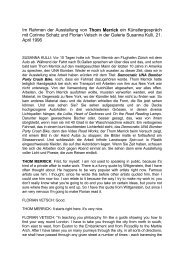Im Rahmen der Ausstellung - Galerie Susanna Kulli
Im Rahmen der Ausstellung - Galerie Susanna Kulli
Im Rahmen der Ausstellung - Galerie Susanna Kulli
Create successful ePaper yourself
Turn your PDF publications into a flip-book with our unique Google optimized e-Paper software.
works there. This is more consistent and significant when I re-use what I know<br />
and what is not supposed to belong to me directly, I mean our cultural surroundings,<br />
views, references. It has to do with different levels of appropriation. You<br />
have it, of course, in the works which represent the works of others, the works<br />
which use the strategies of others overlapped with other strategies, and the mix of<br />
it. At one point I used to say that I never did anything that someone had not done<br />
before. Which was picked up on me when I said that and turned me into a<br />
«Zitatkünstler» in Germany. Which is also ok because I’m happy when people give<br />
me roles. When people tell me, "You are this or that," I always agree. There is always<br />
the chance that someone will think that you are something else. It enlar ges<br />
your personality. As I basically believe I don’t have much. There is the other aspect<br />
of using other people’s work in a way to produce mine. Memory, or what ever.<br />
Then there is also the strategy of using other people’s work without signing them<br />
as my own works, as I do in furniture sculptures. They use constructions which<br />
refer to someone else’s, or to a historical period, or to whatever. This is even more<br />
the case with the shows I’ve been putting together during the past ten years. There,<br />
above all, I’m involved in strategies of perceptions of the works, and in the<br />
overlapping of the works and the overdoing of the implicit information they bring.<br />
So there are two levels of that. The first one is to consi<strong>der</strong> that you never<br />
see a work freed from all that you have in mind while looking at it, from what you<br />
have eaten the day before, what is still in your stomach, the person who made you<br />
be late to see the work, or it’s too hot, and all that, or the fact that you are more a<br />
fan of Mary Beachmoore than of Cézanne, or the day before you saw a show with<br />
Polke or one with Richter, or whatever makes you look at a work differently. There<br />
is no isolation possible. Since this is a given thought, I think there is no ideal unique<br />
way of exhibiting works. I’m always interested in how one puts works to gether,<br />
works of other people or works of myself. I worked on those series of projects<br />
where instead of splitting the works and making a big effort to show them in the<br />
right way, I do it all wrong. I put the works on top of each other, and this is something<br />
I’m working on.<br />
Bice Curiger: «Pudding Overdose» you once called an installation, and since we are<br />
talking about the stomach, can you describe this a bit, this «Pudding Overdose»<br />
John M Armle<strong>der</strong>: It goes into a series of works. The show which was called «The<br />
Pudding Overdose» was done at the art fair in Basel, at the Art & Public gallery<br />
stand. I was asked at that time, some years ago, to choose the works that should be<br />
exhibited and how to exhibit them. I thought about the art fair situation, how to<br />
engineer the show, but I also had other versions of it for a gallery or a museum<br />
show. The art fair situation is like a jungle scene. There is this sort of scenography.<br />
The people walk around, see thousands of things, and they tell you, "I saw a beau





